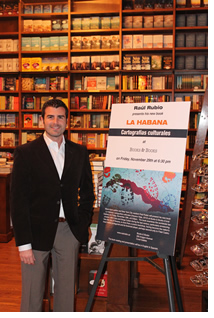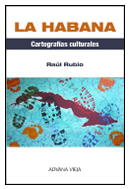Newsroom Archive
 Professor Raúl Rubio of the Department of Foreign Languages and Literatures has published La Habana: cartografías culturales (Aduana Vieja, 2013), a Spanish language volume on the subject of his expertise, the city of Havana.
Professor Raúl Rubio of the Department of Foreign Languages and Literatures has published La Habana: cartografías culturales (Aduana Vieja, 2013), a Spanish language volume on the subject of his expertise, the city of Havana.
The book examines the worldwide fascination with Cuba and things Cuban during the last century, particularly envisioning how the city of Havana, is more than a scenic backdrop, having become the nation’s most visible protagonist and its foremost player, perhaps second only to Fidel Castro.
Presented by the author as a mythical muse, the city has become not only a contested site of politics and ideology, but also a site of virtual activism and newfound enterprise. By reviewing the diverse portrayals of Havana in literature, film and media, the author offers insight as to the city’s future amidst global commercialization.
Rubio’s book takes readers on a journey that begins with the literature and cinema of the1930s through1950s and concludes with his commentary on contemporary times, where the city has become a post-modern imaginary concoction that exists virtually, digitally, and artificially, as an assemblage of an individual’s desires, memories and fantasies.
“My book provides Spanish-language readers with a comprehensive approach to understanding these complex image mechanisms while relating them to ongoing Cuban transnational dilemmas,” said Rubio. “Through the analysis of a diverse cultural repertoire, which includes studies on literature, film, photography, and material artifacts of all sorts, I analyze the city of Havana as a means through which Cuban national identity is re-constructed, artificially, not only by those on the island, but also internationally, with the intention of appeasing memories, desires, and fantasies of what the city symbolizes for both Cubans as well as for aficionados of things Cuban.”
 Rubio’s book approaches to the intersections between Cuban politics, ideology, national identity, and artistic production, both on and off the island. It is organized through studies on a wide-range of artistic mediums, including literature, film, photography, and material products that are manufactured not only in Cuba but also globally. It features new work on the Cuban exile writer Daína Chaviano, filmmaker Fernando Pérez and activist blogger Yoani Sánchez.
Rubio’s book approaches to the intersections between Cuban politics, ideology, national identity, and artistic production, both on and off the island. It is organized through studies on a wide-range of artistic mediums, including literature, film, photography, and material products that are manufactured not only in Cuba but also globally. It features new work on the Cuban exile writer Daína Chaviano, filmmaker Fernando Pérez and activist blogger Yoani Sánchez.
Rubio mentions, “My intention with this book was to offer an alternative take on the complex state of contemporary Cuban national identity, given the existence of a growing Cuban diaspora around the world.”
Rubio’s book was featured recently in an article entitled, "La Habana, Escenario, Paradero, y Visión" by Miami Herald journalist Olga Connor that appeared in the Dec. 25, 2013 edition of El Nuevo Herald (the Spanish-language version of The Miami Herald). Connor includes a review of Rubio's book and particularly highlights his innovative work on Cuban material culture.
To read the full article, click here:
Born in Miami to Cuban parents in the 1970s, Raúl Rubio is a Hispanist and cultural studies scholar, his research is grounded in the emerging interdisciplinary field of material culture, which examines a wide-range of artifacts, from cultural commodities to the museum archive.
 Inside JJC (Faculty & Staff)
Inside JJC (Faculty & Staff) Technology Services Status
Technology Services Status

